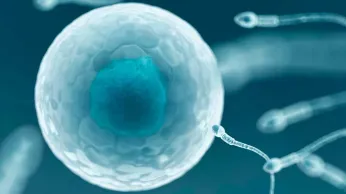
Aug 11
Low Motility, Low Fertility: IVF Has Solutions
Kilian Melloy READ TIME: 2 MIN. SPONSORED
Infertility is a challenge for many families, but for LGBTQ+ families dreaming of parenthood it can be an additional complication on the way to welcoming children into a loving home.
Queer or straight, families yearning for the blessings of biological parenthood need a trifecta of ingredients to come together to create new life: Ova (eggs); sperm, which swim to eggs, fertilize them, and prompt the creation of an embryo; and a uterus (womb), where an embryo can grow and develop until childbirth. It’s increasingly routine for prospective queer parents to turn to fertility care providers to help them accomplish their family-building goals, as they provide guidance through the processes of finding suitable donors and gestational carriers and navigating the clinical procedure involved. This is where fertility interventions like IUI (intrauterine insemination) and IVF (in vitro fertilization) come in — but sometimes fertility issues complicate even the most meticulously made plans.
Infertility can affect an individual from any community, regardless of sexual orientation, gender identity, or ideological convictions. It is, in an unfortunate way, an equalizer. But there’s a more conscientious equality at work at the 90+ clinics comprising The Prelude Network, North America's largest and fastest-growing network of fertility care providers, where LGTBQ+ people find they are heard, respected, and guided with the same expertise and care as anyone else.
One family building option is IUI, which involves stimulating the release of ova, or eggs, for a person with ovaries and then introducing sperm to the uterine cavity via a thin catheter, where fertilization can then take place. IVF, on the other hand, involves stimulating ovaries to produce multiple eggs, then removing the eggs, or ova, from the body before ovulation and uniting them with sperm cells under laboratory conditions. Resulting embryos can be genetically tested before being implanted in the uterus of a prospective parent or a gestational surrogate.

Source: Getty
Fertility issues can add an extra step to the process leading to conception, but, with modern medical science, that step need not be a stretch or a stumble. What’s more, science doesn’t just light the path to parenthood despite fertility challenges; it shines a light on the facts surrounding those challenges. Literature and cultural assumptions might place the blame for infertility on people with uteruses and ovaries, but it takes two to tango and individuals with wombs and ova are not the only players in the great game of life. Sperm quantity and quality can account for infertility, too.
Within the world of fertility care, fertility issues having to do with the production and motility (movement) of sperm is broadly known as “male factor infertility,” though it applies generally to people with sperm and testes. That is to say: Just as might happen with their heterosexual and cisgender peers, LGBTQ+ people with sperm might find that their swimmers don’t swim so well or are not present in the usual numbers. There are around ten million sperm in a typical sample, which sounds enormous, but fewer sperm can mean the difference between easy conception and years of frustration.
Why does motility matter, and why are sperm typically present in such large numbers? In part, it’s due to the distance sperm must typically travel to fertilize an egg. If deposited in the vaginal canal via the “old-school” method of sexual intercourse, sperm cells — nourished by semen, which also serves as a fluid environment in which sperm can travel — must make their way to, and into, the fallopian tubes, of which there are two. But typically, if an egg is present, it’s only in one of those two tubes — and the egg is not simply sitting there: In the last few years, IVF has afforded researchers the chance to see how eggs attract sperm with “chemoattractants,” that help guide the sperm in the right direction — some “targeted” sperm, anyway, thought by scientists to be more compatible with the egg. The swim might not seem a long one from our perspective, but in the microscopic world of sperm and ova the transport of a sperm cell is something of an epic, taking place against natural forces like gravity and the receptive partner’s immune system.

Source: Prelude Fertility
Problems can occur even before sperm begin their odyssey. Simply producing enough sperm, and sperm of the right quality, can be a hurdle involving a number of factors. Dr. Michael Witt, a male fertility specialist with Prelude Network clinic Reproductive Biology Associates (RBA) in Atlanta, Georgia, explains that “there's a lot of different things that can account for that. In the production problem, you can have toxins that can be certain prescription medications, chemotherapeutic agents, recreational drugs” — with marijuana use being an example of the latter that, Dr. Witt says, can interfere with sperm production.
“A real common cause currently would be the use of testosterone,” Dr. Witt adds. “A lot of men are taking that, and it kind of shuts off sperm production.” Moreover, he notes, “genetic issues can create problems with the number of chromosomes, or the actual makeup of certain chromosomes.”
One key takeaway: If you’re planning to compete for a bodybuilding title and intend to use testosterone to help you get there… or even if you’re using T due to naturally low levels… it’s important to be aware of the potential effects on fertility. The same is true of the use, medicinal or otherwise, of substances like THC.
For those factors, as well as other medical considerations — cancer treatment, for instance — Dr. Witt notes that there’s an easy workaround, if it’s made use of early enough. “If there are anticipated situations where you're going to lose production or even transportation — like, if you're getting a vasectomy, or if you are transitioning and want to preserve sperm — you can freeze sperm for future use,” he says. Known as fertility preservation, the long-term cryogenic storage of sperm (or of eggs, for women) can be a way to ensure that one’s fertility continues into the future, whether anticipated challenges to fertility result from medical interventions or simply the aging process and its inevitable impact on reproductive prospects.
Some causes of infertility aren’t as treatable as others, and, Dr. Witt notes, in about a third of the cases no obvious reason for infertility can be found. But here, too, IVF can help.
“You at least give them the opportunity to get sperm to a place where it can function and fertilize and form an embryo,” Dr. Witt says of the procedure, adding that even when sperm counts are extremely limited, IVF is a reliable method for potentially achieving pregnancy. “We've had cases where there's just been single-digit numbers of sperm that you either find in the ejaculate, or potentially even in the testicle, that you could utilize with IVF,” he recounts, before adding that, before the advent of modern fertility treatments, “there was no option to potentially use that sperm with any degree of success.”

Source: Getty
Some causes for a low sperm count or low sperm motility might well be reversible, but whether that is the case or not, Dr. Witt notes, IVF or IUI can be “a vehicle to get sperm where they need to be… and can compress the timetable to get pregnant.” IVF, in particular, can be a means to preserving fertility, as well as achieving pregnancy.
“What IVF does is it enables patients to get a higher pregnancy rate, very quickly,” Dr. Witt explains. “Yet, also in that setting, IVF can give them the potential to initiate maybe a second or a third pregnancy without having to repeat that process” of stimulating, extracting, and fertilizing eggs, the reason being embryos — like sperm and ova, as noted earlier — can be cryopreserved for years, or even decades, before implantation. That means that one round of embryo creation through IVF can create embryos enough for the two, three, or more children a couple might plan to have years in advance of their eventual births.
Speaking to his own interest in fertility treatment, Dr. Witt demonstrates the kind of inclusive, compassionate expertise that prospective parents find when they turn to The Prelude Network. “I started off in an academic setting, working with some reproductive endocrinologist, but it was very compartmentalized,” he recalls. “The two things that drew me to RBA were, one, the ability to provide comprehensive care at one place, which enables couples to get more cohesive and more efficient care.
“But also, it was that kind of collaboration to come up with a lot more innovative ways to treat a couple,” Dr. Witt goes on to say. “For them, and also for me, it was very rewarding. It felt like they'd come to a place that they didn't have to go anywhere else, and it felt like they were getting both sides of the equation evaluated and then being able to offer them a lot of different options from which they could choose to align with their goals.”
All families are unique, and each family deserves specialized and knowledgeable attention. That’s the ethos behind the care offered by The Prelude Network.
Kilian Melloy serves as EDGE Media Network's Associate Arts Editor and Staff Contributor. His professional memberships include the National Lesbian & Gay Journalists Association, the Boston Online Film Critics Association, The Gay and Lesbian Entertainment Critics Association, and the Boston Theater Critics Association's Elliot Norton Awards Committee.






